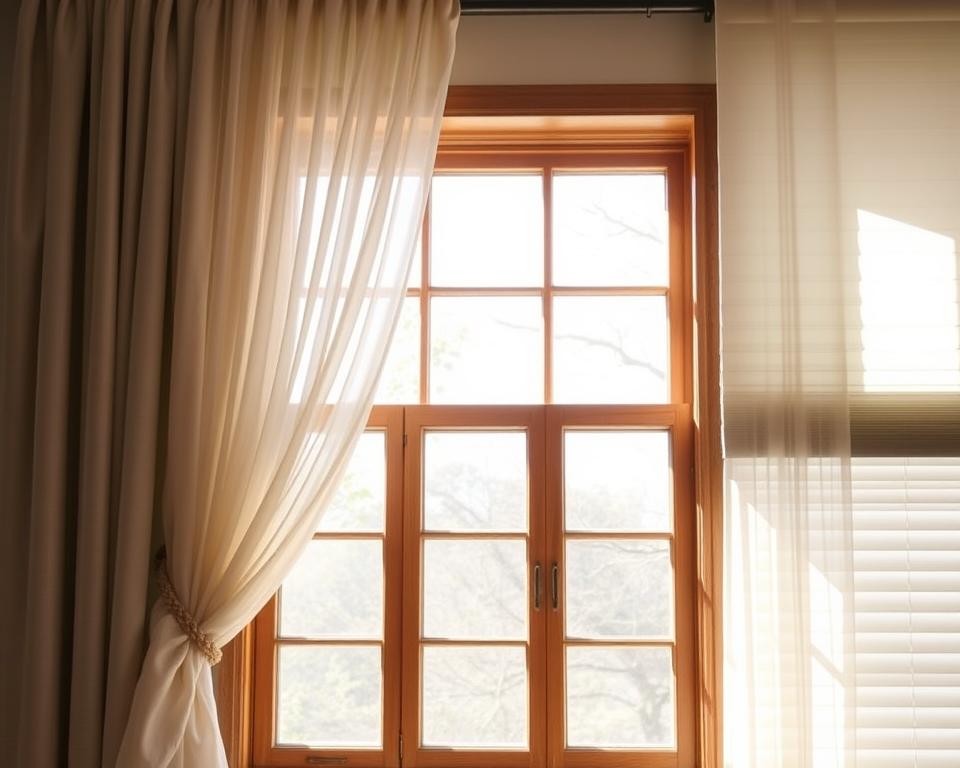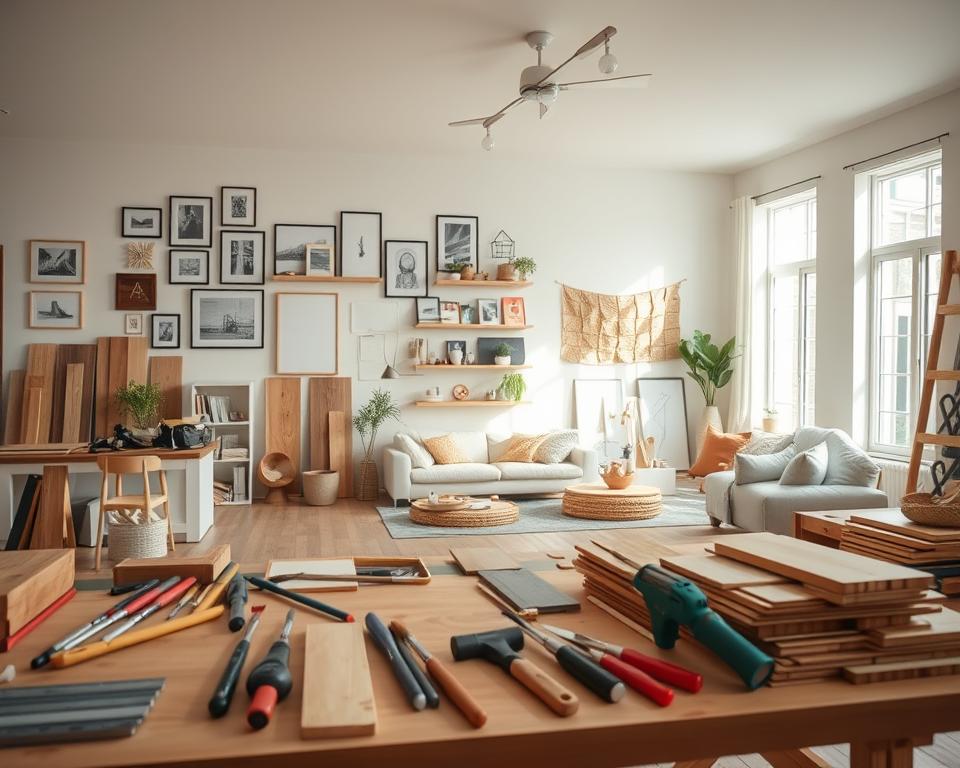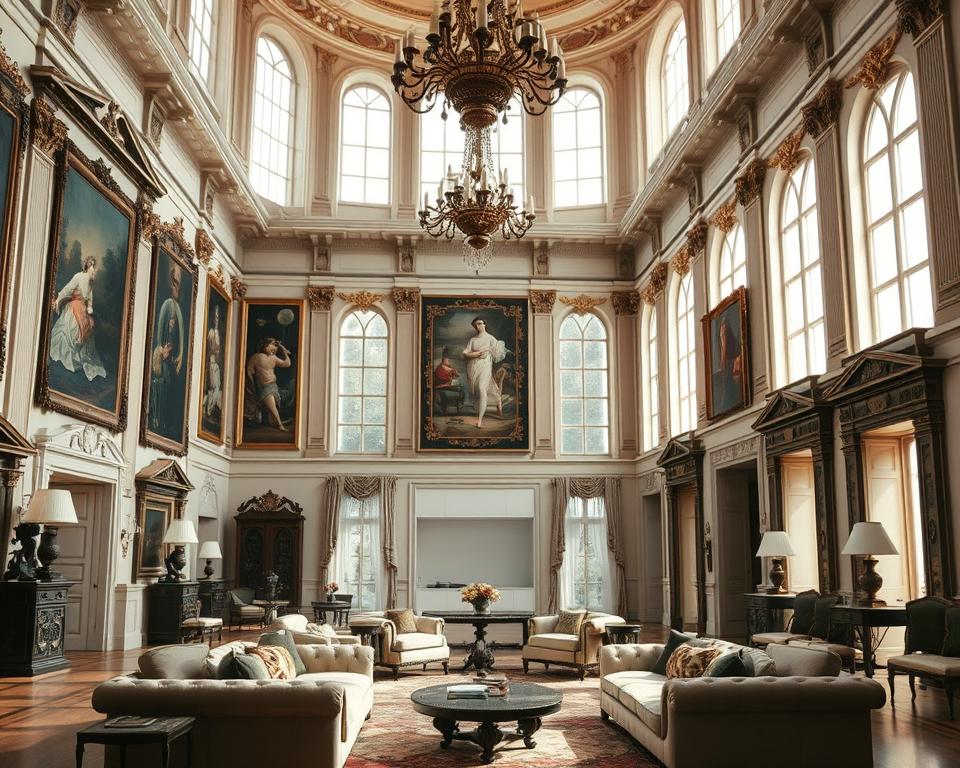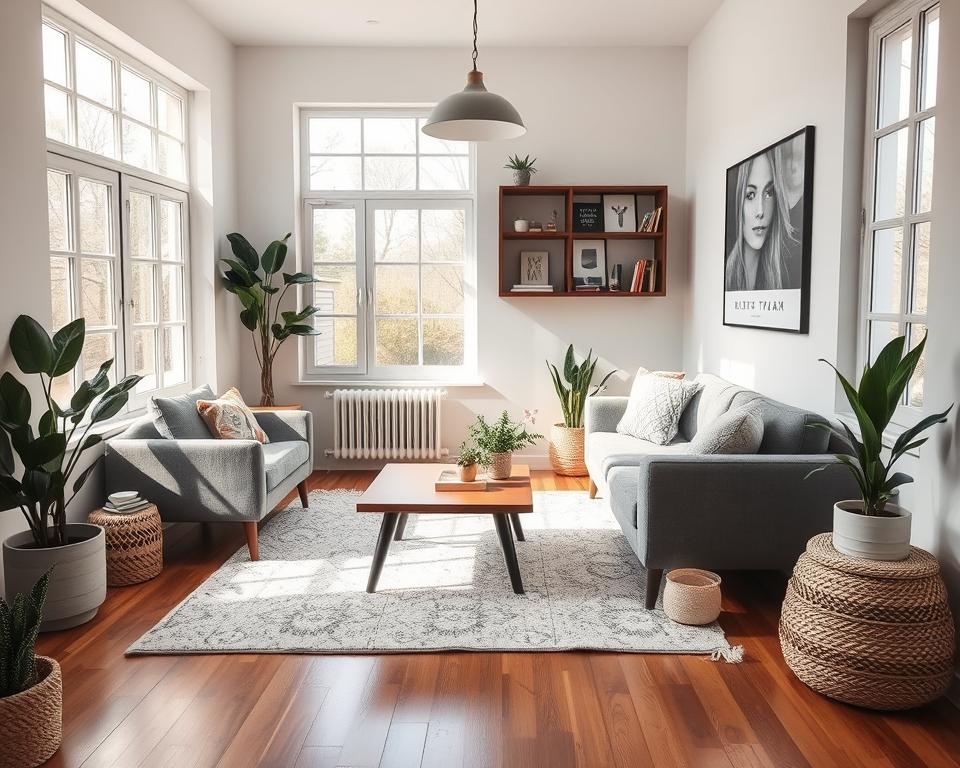Turn your vision into reality—learn how to design and transform your space with easy DIY steps!
Welcome to your go-to interior design guide. Here, we help you transform your living spaces with ease and creativity.
This guide is packed with practical tips, modern ideas, and design inspiration. It’s perfect whether you want to refresh a room or redo your whole home.
Designing your home doesn’t have to be overwhelming or expensive. With the right approach and a touch of creativity, you can transform any space into a stylish and functional environment.
You’ll learn about expressing yourself through home decoration. We’ll cover topics that will light up your DIY path. Let’s start this exciting journey together!
Read more:
Discover the Best Interior Design Online Courses: A Complete Guide
Explore Interior Design Career Options: A Comprehensive Guide to Professional Opportunities
DIY Home Makeover: Easy Interior Design Hacks
Maximizing Small Spaces: Creative Interior Design Solutions
Key Takeaways
- Discover your unique interior style and how to express it.
- Learn to create a detailed and effective design plan.
- Understand color psychology and how it affects your space.
- Select the right furniture and decor to elevate your design.
- Maximize space efficiency through clever layout design.
- Incorporate lighting effectively for enhanced ambiance.
- Personalize your space with art and accessories that resonate with you.
Understanding Your Design Style
Knowing your design style is key to any decorating project. It helps you make choices that fit your taste. Think about what you’ve liked before and what you already have at home.
Identifying Personal Aesthetic
Start by figuring out what you love in design. Make a mood board with your favorite colors, textures, and styles. This helps you see what you really like.
Look at your current space and see what you already like. Think about how it makes you feel. Also, note any trends that catch your eye.
Common Interior Design Styles
Knowing popular styles can help you understand your own better. Some common ones are:
- Contemporary
- Rustic
- Mid-century Modern
- Minimalist
- Industrial
Each style has its own look. Knowing them helps you express your own style. Whether you like modern or rustic, it’s all about what you enjoy.
Mixing and Matching Styles
Mixing styles can make your space truly yours. Make sure everything fits well together. Use colors and textures that work well together.
Let current trends guide you. But keep your design consistent. Use patterns or themes to tie everything together.
Creating a Design Plan
Starting a design project needs careful planning for success. A good design plan helps you achieve your desired look. It includes setting clear goals, budgeting, and planning timelines for each step.
Setting Clear Goals
Start by defining what you want to achieve. Knowing your goals helps guide your decisions. Think about the purpose of each room and what activities will happen there. This clarity will help in choosing the right look and function for your space.
Budgeting for Your Project
Good budgeting is key to a stress-free design project. Start by listing all costs for materials, labor, and decor. Use a percentage-based budget to divide your funds among different areas like furniture and flooring.
| Item | Estimated Cost (%) | Actual Cost |
|---|---|---|
| Furniture | 30% | $900 |
| Paint | 15% | $450 |
| Decor | 20% | $600 |
| Flooring | 25% | $750 |
| Miscellaneous | 10% | $300 |
Keep some room in your budget for surprises that might come up.
Timeline Considerations
Having a timeline is crucial for keeping your project on track. A good schedule includes all project phases and important tasks like ordering materials and hiring contractors. Don’t forget to include time for inspections and approvals.
By planning well, you can ensure a successful and enjoyable interior makeover.
Choosing Your Color Palette
Choosing the right color palette can greatly change how your space feels. Knowing how colors affect us helps pick the right ones. Each color brings its own mood, helping you create the perfect atmosphere.
The Psychology of Color
Colors can make us feel certain ways and change our mood. For example:
- Red makes us feel energetic and passionate.
- Blue brings calm and peace.
- Yellow makes us happy and cheerful.
- Green connects us to nature and refreshes us.
- Purple sparks creativity and luxury.
Knowing these effects helps you pick colors that make your home feel better.
Color Selection Tools
There are many tools to help pick a color palette. Some useful ones are:
- Color wheels show you colors that go well together.
- Digital resources like Adobe Color help create custom palettes.
- Mobile apps let you capture colors from pictures for your decor.
These tools make it easier to see how colors work together, helping you choose a look you’ll love.
Sample Testing Techniques
Testing colors before deciding is a smart move. Here are some ways to do it:
- Apply paint swatches on walls to see how colors look in different light.
- Use tester pots to paint big areas for a true view of the color.
- Get fabric samples to check how colors match your furniture.
Trying these methods ensures your chosen colors match your dream home.
Selecting Furniture and Decor
Choosing the right furniture and decor can turn a house into a home. Essential pieces are both functional and beautiful, making your space more comfortable and attractive. Think about how each piece fits into the room’s flow and function.
Essential Furniture Pieces
Start with key furniture items like a good sofa, dining table, and comfy chairs. Pick items that match your style and are durable and comfy. Quality furniture lasts long, letting you enjoy your space for years.
Sourcing Unique Decor Items
Adding your personal touch goes beyond furniture. Look for unique home decorations at local shops and online. Thrift stores, art fairs, and craft markets have special items that make your home stand out. Mixing styles creates a unique atmosphere, making your space truly yours.
Sustainable Options for Home Furnishings
Choosing sustainable furniture is key in today’s world. Look for pieces made from reclaimed wood, recycled materials, or from eco-friendly companies. This choice is good for the planet and adds natural beauty to your decor. Brands like West Elm and Crate & Barrel have a wide range of sustainable furniture, so you can choose stylish, eco-friendly options.
Maximizing Space Efficiency
Creating an efficient layout is key for making the most of small spaces. Choosing the right furniture can change how a room looks and works. Using space-saving designs ensures every inch is used well.
Layout Optimization Tips
To improve your layout, first think about how people move through the space. Here are some tips:
- Focus on key areas like seating and dining, making sure they’re easy to get to.
- Use rugs to mark off different areas and add a unified look.
- Place big furniture against walls to keep paths clear.
Using Multi-Functional Furniture
Choosing furniture that does more than one thing is smart for saving space. Look for items that have a double role, such as:
- Ottomans that also store things, great for hiding mess.
- Sofa beds that turn into beds for when guests come over.
- Coffee tables with hidden storage, perfect for keeping things tidy.
Creating Visual Space
To make a room feel bigger, focus on visual tricks. Here are some ways to do it:
- Keep decorations simple to avoid cluttering the space.
- Use mirrors to bounce light and make the room seem deeper.
- Choose light colors for walls and furniture to make the room feel airy.
Lighting Your Space
Lighting design is key to a room’s feel. Knowing the types of lighting and how to use them is important. A mix of ambient, task, and accent lighting can change a room’s mood.
Types of Lighting Explained
Lighting is mainly divided into three types:
- Ambient Light: This is the main light source. It lights up the whole room evenly.
- Task Lighting: This light is for specific tasks, like reading or cooking. It focuses light where needed.
- Accent Lighting: This highlights certain parts of the room. It adds depth and interest.
Layering Light for Ambiance
Layering different lights can change a room’s mood. Mixing ambient, task, and accent lighting lets you adjust the atmosphere. For example, dimming ambient light and adding accent lighting can make a room cozy.
Using dimmers makes it easy to adjust the light levels. This flexibility is great for any occasion.
Natural vs. Artificial Light Considerations
Natural light greatly affects a room’s feel. Think about where to place windows and use light-colored curtains to let in more sunlight. This improves the room’s look and feel.
Even with natural light, choosing the right artificial lighting is crucial. Look for energy-efficient LED lights that match your design. They come in many styles to fit your needs.
Flooring Fundamentals
Choosing the right flooring is key to a room’s look and function. Different materials have unique qualities that match various lifestyles and styles. Knowing these options helps homeowners make smart choices, especially for durable materials.
Popular Flooring Options
There are many flooring choices to fit different tastes and needs. Here are some top picks:
- Hardwood: Classic and warm, adding elegance.
- Tile: Durable and water-resistant, perfect for wet areas.
- Laminate: Affordable and easy to install, looks like wood or stone.
- Carpet: Comfortable and absorbs sound, great for cozy spaces.
Pros and Cons of Different Materials
Each flooring has its own benefits and drawbacks. This table gives a quick comparison:
| Flooring Type | Pros | Cons |
|---|---|---|
| Hardwood | Durable, easy to clean, boosts home value | Can scratch, pricey |
| Tile | Water-resistant, many design options | Can be cold, slippery |
| Laminate | Affordable, simple to install, stain resistant | Less durable than wood, may fade |
| Carpet | Soft, good for sound | Stains easily, allergens |
Maintenance Tips for Longevity
Keeping your flooring in top shape is vital. Here are some key tips:
- Hardwood: Polish and clean with a damp mop to avoid water damage.
- Tile: Seal grout and clean with a neutral cleaner to prevent stains.
- Laminate: Clean with a laminate-safe cleaner and a damp mop to avoid warping.
- Carpet: Vacuum often and get professional cleaning every 12-18 months.
Window Treatments and Treatments
Window coverings are key to making your home look good and work better. You can choose from curtains or blinds, each changing how your space feels. This part talks about the different kinds of window coverings and how to pick the right ones for you.
Types of Window Coverings
There are many types of window coverings to pick from:
- Curtains: These add softness and elegance, making rooms feel warmer.
- Blinds: A structured choice, blinds control light well and look modern.
- Shades: Shades, like Roman and roller, add a special touch to any room.
- Drapes: Similar to curtains but lined for better insulation and light blocking.
Choosing the Right Material and Style
Picking the right material for your window coverings is important. Think about these things:
- Light Control: Do you want full darkness or just a bit of light?
- Insulation: Some materials keep heat in, saving energy.
- Aesthetic Appeal: Choose styles that match your home’s look.
Looking at different styles and trends can help you pick the best one for your vision.
DIY Vs. Professional Installation
There are two ways to install window coverings: DIY or professional. Each has its own benefits:
- DIY Installation: It’s cheaper and can be rewarding. It’s good for those who have basic tools and skills.
- Professional Installation: It ensures a perfect fit, giving a polished look.
Think about your skills before choosing. A good installation makes your window coverings look and work better.

Personalizing With Art and Accessories
Make your space truly yours by choosing the right personal artwork and home accessories. Each item should have a story or emotion behind it. This will make your home feel more welcoming and personal.
Finding the Perfect Artwork
Art is key in any home, letting you show off your style. Look for pieces that speak to you, like local artists or prints of your favorite scenes. Think about how the frame fits with your decor too.
- Local artists for unique, original works
- Prints or reproductions that capture your favorite scenes
- Framing options that complement the artwork and your decor
Art can spark creativity and be a highlight in your design. Pick pieces that match your room’s colors to make them stand out.
Accessorizing with Purpose
Accessories should add beauty and function. Think about how they look and what they do. Choose items that fit with your decor and serve a purpose, like stylish storage.
- The balance between aesthetics and utility
- Color coordination with existing decor
- Choosing functional items like stylish storage solutions
Things like decorative trays, unique vases, or books can make your home richer. They add beauty and serve a purpose. Thoughtful choices can make even simple spaces look great.
Creating a Gallery Wall
A gallery wall is a great way to show off your favorite art. Here’s how to make a beautiful one:
- Choose a consistent theme or color scheme to unify the pieces.
- Mix different sizes and shapes for an eclectic feel.
- Arrange your art on the floor first to experiment with placement.
- Use various framing styles to add depth and interest.
Follow these tips to create a stunning gallery wall. It will showcase your favorite pieces and tell your story beautifully.
The Importance of Textiles
Textiles are key to making a home cozy and stylish. Choosing the right fabrics lets homeowners show off their taste. From curtains to upholstery, various textiles greatly impact a room’s feel. Adding different textures can make your decor pop, adding depth and interest.
Choosing Fabrics for Comfort
Comfort should be your main goal when picking fabrics. Look for materials that feel soft and warm, like cotton, velvet, or linen. Each fabric has its own special qualities:
| Fabric Type | Comfort Level | Durability | Best Uses |
|---|---|---|---|
| Cotton | Soft and breathable | Moderate | Cushions, curtains |
| Velvet | Lush and warm | High | Sofas, bedding |
| Linen | Light and airy | High | Tablecloths, drapes |
Layering Textures for Depth
Mixing different textures is vital for a cozy feel. Using items like knitted throws, silk pillows, and wool rugs can really make a space feel welcoming. This mix not only adds charm but also invites you to touch, making your home more engaging.
Seasonal Textile Swaps
Changing your home textiles with the seasons is a great way to update your decor without spending a lot. Switch to lighter fabrics in spring and summer, and heavier ones in fall and winter. This keeps your space comfy and fresh all year.
Incorporating Plants and Greenery
Bringing nature indoors has many benefits. Indoor plants make your space look better and improve your health. They help clean the air and create a calm vibe. Adding them to your home can make dull areas lively.
Benefits of Indoor Plants
Indoor plants do more than just look good. They have many benefits:
- Air purification: Many plants clean the air by removing harmful pollutants.
- Stress reduction: Greenery makes your space feel more relaxing and peaceful.
- Enhanced mood: Caring for plants can make you happier and more satisfied.
Best Plants for Different Spaces
Choosing the right plants for your space is key. Here are some top picks:
| Plant Type | Ideal Conditions | Care Level |
|---|---|---|
| Snake Plant | Low light | Low |
| Pothos | Indirect light | Easy |
| Fiddle Leaf Fig | Bright, indirect light | Moderate |
Care Tips for Indoor Gardening
To keep your plants healthy, follow these care tips:
- Check for pests and diseases regularly to keep your plants healthy.
- Water only when the top inch of soil is dry to avoid root rot.
- Give each plant the right amount of light to help them grow.
Finalizing Your Design
When your project is almost done, it’s key to check if it meets your goals and style. Look closely at how each part fits together and if it meets your daily needs. Take a step back and see your space from different views. This helps you find small changes or improvements.
Small tweaks can make a big difference in how your space feels. Maybe moving furniture or adding the last details to complete the look. These changes can really enhance your home’s atmosphere. It’s also smart to write down your thoughts for future design plans. This is helpful as your tastes change or your needs grow.
Thinking about future updates is also important for a lively home. Being open to new styles and trends makes it easy to refresh your decor. For more on this, check out a detailed guide on working with designers. This ensures your home stays in style as your life changes. Learn more about the process here.



